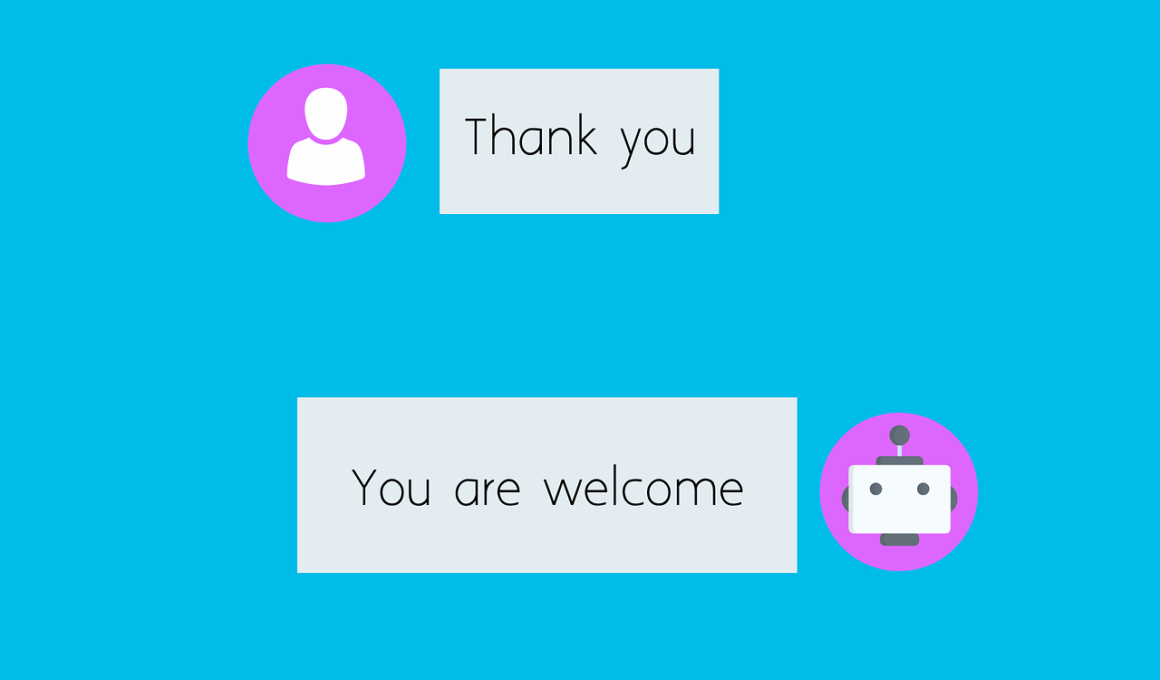Measuring the Success of Chatbot-Driven Social Media Customer Support
In today’s digital realm, chatbots stand out as vital instruments enhancing social media customer support. Their efficiency can transform how businesses interact with customers while providing immediate assistance. These tools can answer queries ranging from order status to general inquiries, ensuring instant engagement. This approach not only boosts customer satisfaction rates but also creates a seamless experience. Chatbots excel due to their availability; they work without breaks, serving customers around the clock. Furthermore, they can handle multiple interactions simultaneously, reducing wait times considerably. Organizations must implement measurable goals involving performance metrics such as response times, issue resolution rates, and customer satisfaction scores to evaluate their effectiveness. This transformation provides valuable insights into areas needing improvement while increasing operational efficiency. The analytical capabilities of chatbots enable businesses to assess customer feedback and adjust their strategies accordingly. Additionally, understanding user interactions can guide chatbot training for increased accuracy. Ultimately, harnessing chatbots requires a strategic approach to measure success accurately. Monitoring these metrics reveals precise actions for further enhancement, ensuring customer service evolves alongside expectations and tech advancements.
Key Performance Indicators (KPIs) for Chatbot Success
To gauge the success of chatbot-driven social media support, some KPIs play crucial roles. First, response time greatly impacts customer satisfaction, and shorter times generally indicate better service. Next, tracking issue resolution rates provides specifics regarding how effectively chatbots handle inquiries. If the chatbot resolves a high percentage of queries without human intervention, it signifies high performance levels. Another significant benchmark is customer satisfaction, often measured through follow-up surveys. Businesses can analyze the data collected via these surveys to refine chatbot responses and improve interactions. A fourth critical metric is conversation completion rates; high rates reflect successful engagements while low rates may necessitate refinement or additionally enhanced training for the chatbot. Moreover, retention rates showcase how many customers return to utilize chatbot services, showing loyalty and satisfaction. Additionally, monitoring customer feedback offers deeper insights into user experience, further guiding future enhancements or adjustments needed. Businesses must also evaluate operational cost savings due to chatbot implementation, as well as how it relates to the overall efficiency improvements resulting from usage. Ultimately, simultaneous tracking of these KPIs will paint a clearer picture of chatbot success.
Engagement metrics also serve as indicators of chatbot performance in social media settings. Tracking user interactions can help determine whether the chatbot creates satisfactory experiences. Time spent engaging with the chatbot is vital; it can show how customers perceive value during interactions. High engagement often correlates with effective workflows, making it essential to understand this relationship. Additionally, the number of messages exchanged can provide insights into user experience; longer conversations might suggest either successful guidance or overcomplicated interactions needing simplification. Regular analysis of these metrics allows businesses to make adjustments enhancing user interfaces and simplifying chatbot conversations. Analyzing drop-off rates during interactions can unveil points where users lose interest, indicating potential flaws in the dialogue flow or misinterpretation of user intent. Continuous improvement offers enhanced customer experiences while fostering brand loyalty. Using A/B testing provides further valuable insights by presenting different chatbot scripts or responses to varied customer segments. The data obtained enables organizations to tailor conversations better to customer needs and preferences, leading to higher satisfaction rates. Tracking these engagement metrics ultimately equips businesses with insights necessary for ongoing success in leveraging chatbots for social media customer support.
Customer Feedback and Satisfaction Surveys
Implementing customer feedback and satisfaction surveys after chatbot interactions offers invaluable insights. Customers can reflect on their experiences and highlight areas where support excels or falls short, providing direct input for ongoing improvement. Surveys can occur immediately after interactions or through follow-up emails, creating multiple opportunities for feedback. Collecting responses related to satisfaction ratings, perceived helpfulness, and overall experiences informs future training and adjustment needs for chatbots. Furthermore, qualitative feedback is equally significant, allowing users to express their opinions more freely. This information can be vital in understanding the nuanced expectations and preferences of a diverse clientele. Look for common themes in feedback to grasp specific areas requiring enhancement or aspects of the chatbot that delight customers. Analyzing this qualitative input can lead to effective modifications that align better with user sentiments. While quantitative metrics provide an overview of performance, combining them with qualitative insights enables a more holistic understanding. Ultimately, feedback forms critical components of the customer journey, providing information that fuels continuous enhancements and fosters lasting connections between brands and their clients.
Further, leveraging tools such as sentiment analysis can aid in interpreting customer feedback effectively. Understanding customer emotions through sentiment analysis can reveal genuine user impressions and experiences. This data can help categorize responses as positive, negative, or neutral, filtering out more contextual insights. By collecting feedback effectively, organizations can prioritize adjustments based on actual user feelings, leading to more customer-centric services. Comparatively assessing changes in customer sentiment over time can provide insight into whether implemented enhancements lead to positive outcomes. These data-driven approaches ensure businesses remain responsive to customer needs, driving engagement and satisfaction. Additionally, monitoring social media mentions and conversations related to the chatbot can offer a broader view of user experiences and expectations. Social listening tools can alert brands to emerging trends or issues, guiding responses and developments accordingly. Addressing customer concerns raised on social media ensures brands remain proactive and timely in their approaches. Ultimately, integrating various feedback channels offers a multi-faceted view of chatbot performance, which helps refine strategies and improve customer service consistently.
Impact of Chatbots on Brand Loyalty
Brand loyalty significantly benefits from successful chatbot-driven social media customer support. When customers have seamless interactions, they are more likely to perceive the brand positively. The effectiveness of chatbots in addressing issues promptly can significantly boost customers’ trust in the brand. Additionally, consistent and reliable communication further encourages customers to engage more frequently with the brand. Establishing positive experiences through chatbot interactions creates favorable associations, fostering customer loyalty. Brands should also recognize that personalized customer interactions via chatbots enhance engagement. Tailoring responses based on past interactions or preferences can significantly improve user experiences. Successful personalization leads customers to feel valued, establishing a stronger bond between consumers and the brand. Moreover, monitoring repeat engagement levels can indicate how chatbot performance impacts brand loyalty over time. As companies develop and refine their chatbot technologies, this will enhance customer interactions and retention rates. Building a reputation for exceptional support through chatbots ultimately strengthens the brand’s presence in competitive markets. Assessing loyalty indicators, such as customer lifetime value and net promoter scores, will illustrate the overall impact of chatbots, establishing clear indicators tied to the success of customer support initiatives.
In conclusion, measuring the success of chatbot-driven social media customer support requires a multifaceted approach. Organizations must employ a diverse range of metrics to assess chatbot performance thoroughly. Considering KPIs, engagement metrics, customer feedback, and loyalty indicators provides a comprehensive overview of effectiveness. Emphasis on tracking these diverse parameters ensures firms can understand how chatbot implementation impacts their customer service strategies. Success in this domain leads to satisfied customers, driving brand loyalty and increasing operational efficiency. Effective measurement reinforces the commitment to continuous improvement while keeping pace with emerging tech advancements. Brands that recognize and adapt to the dynamic nature of customer expectations through chatbots will engage better with their audiences. Moreover, the strategic integration of chatbot performance insights into business strategies will improve overall service quality. Continuous adaptation and responsiveness to customer feedback will empower brands to remain competitive as social media evolves. Therefore, fostering a customer-centric approach through chatbots paves the way for ongoing success. Harnessing these tools effectively ensures optimal customer interactions, promoting long-term relationships between brands and their customers, while cultivating brand loyalty as the ultimate goal.


